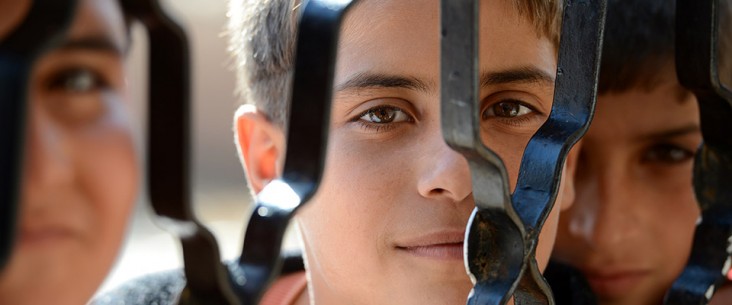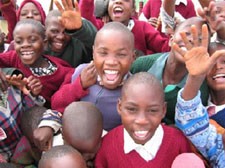- What We Do
- Agriculture and Food Security
- Democracy, Human Rights and Governance
- Economic Growth and Trade
- Education
- Ending Extreme Poverty
- Environment and Global Climate Change
- Gender Equality and Women's Empowerment
- Global Health
- Water and Sanitation
- Working in Crises and Conflict
- U.S. Global Development Lab

At a Glance
THE TOLL ON CHILDREN
HIV and AIDS have exacted a terrible toll on children and their families. During the 30 years of the global HIV epidemic, an estimated 17 million children lost one or both parents due to AIDS. Ninety percent of these children live in sub-Saharan Africa. In addition, 3.4 million children under age 15 are living with HIV. Despite some decline in HIV adult prevalence worldwide and increased access to treatment, the number of children affected by or vulnerable to HIV remains alarmingly high.
Families and communities have led a massive response to protect, care for and support children affected by HIV and AIDS. Since 2003, the U.S. President’s Emergency Plan for AIDS Relief (PEPFAR) has provided more than $2 billion in funding and technical support to greatly enhance these efforts. These investments have enabled children to stay in school, strengthened households and ensured families continue their roles as primary caregivers.
Photo Gallery
-

The AIDS Support Organization (TASO) center in Mbarara, Uganda
A young girl plays “mama” to a stuffed animal in the Children’s Room at TASO in Uganda. While caregivers participate in support groups and educational sessions, their children can engage in stimulating play. Many are also receiving treatment at TASO. Photo credit: USAID/Tash McCarroll.
-

Youth Care Workers
An Isibindi child and youth care worker reads to children at a community Safe Park in Soweto, South Africa. Photo credit: USAID/Tash McCarroll.
-

Facilitating Strong Partnerships Across Communities and Sectors
Young herders are trained in beadwork through the MSH-GROW project and sell their handiwork at local churches and village markets in Malefiloane, Lesotho. Photo credit: USAID/Tash McCarroll.
-

MUAC Measurement
A village health trainer conducts a nutritional assessment on a 2-year-old who was abandoned at birth. The child, who is now being cared for by grandparents and an aunt, receives therapeutic feeding and other nutritional support through AVSI-SCORE. Photo credit: USAID/Tash McCarroll.
-

Educational Session on Parenting
A mother and her baby participate in an interactive parenting skills session at The AIDS Support Organization (TASO) center in Mbarara, Uganda. Photo credit: USAID/Tash McCarroll.
-

Hima Miracle Child
SUNRISE-OVC social workers support adopting families. Photo credit: USAID/Tash McCarroll.
-

A Community Social Worker Home Visit in Kasese, Uganda
Through the SUNRISE program, a teen mom in Uganda is supported by her family and community to stay in school. Photo credit: USAID/Tash McCarroll.
-

Learning a Trade with the Help of PACT-GROW in Molumong, Lesotho
Youth learn a trade with the help of PACT-GROW in Molumong, Lesotho. Photo credit: USAID/Tash McCarroll.
-

Savings and Agriculture in Lesotho
A young woman reaps the benefits of MSH-GROW in Mokhotlong, Lesotho. Photo credit: USAID/Tash McCarroll.
-

Building Family Resilience with Economic Strengthening and Social Protection
Jonathan (far right) stands in front of his house with his wife and three children. With support from the AVSI-SCORE Project, the family has received training in farming techniques and financial literacy. Photo credit: USAID/Tash McCarroll.
-

Greater Rape Intervention Program (GRIP) in South Africa
GRIP in South Africa provides support to child and women survivors of sexual violence in drop-in centers located in 26 hospitals, police stations and courtrooms throughout South Africa. Each child survivor also receives a hand-knit teddy bear. Photo credit: GRIP.
USAID’S RESPONSE

The U.S. Agency for International Development’s (USAID’s) programs for orphans and vulnerable children (OVC) affected by HIV and AIDS contribute to the achievement of an AIDS-free generation by responding to the social, economic and emotional consequences of the disease on children, their families and the communities that support them. The goal of USAID and PEPFAR’s Orphans and Vulnerable Children Program is to improve the health and well-being of children and families by mitigating the impact of HIV and AIDS and increasing children’s resilience and reducing their risk to the disease. Key program areas and objectives include the following:
- Education: Support efforts to reduce educational disparities and barriers to access among school-age children through sustainable “systemic” interventions.
- Psychosocial Care and Support: Prioritize psychosocial interventions that build on existing resources; place and maintain children in stable and affectionate environments.
- Household Economic Strengthening: Reduce the economic vulnerability of families and empower them to provide for the essential needs of the children in their care.
- Social Protection: Reduce vulnerability and risks, foster human capital development and interrupt the transmission of poverty from one generation to the next.
- Health and Nutrition: Improve children’s and families’ access to health and nutritional services.
- Child Protection: Develop appropriate strategies for preventing and responding to child abuse, exploitation, violence and family separation.
- Legal Protection: Develop strategies to ensure basic legal rights, birth registration and inheritance rights to improve access to essential services and opportunities.
- Capacity Building: Prioritize capacity building and systems strengthening interventions according to country context.
WHERE WE WORK
USAID has programs for orphans and vulnerable children in the following countries:
| Botswana | Haiti | South Africa |
| Burundi | India | South Sudan |
| Cambodia | Kenya | Swaziland |
| Cameroon | Lesotho | Tanzania |
| Cote d’Ivoire | Malawi | Uganda |
| Democratic Republic of the Congo | Mozambique | Ukraine |
| Ethiopia | Namibia | Vietnam |
| Ghana | Nigeria | Zambia |
| Guyana | Rwanda | Zimbabwe |
BUILDING THE EVIDENCE BASE
Strong monitoring and evaluation systems are an essential foundation to improve the effectiveness of programs. USAID and PEPFAR will continue to scale up and ensure robust monitoring of existing high-impact OVC programs and to support countries in developing, implementing and evaluating OVC pilot programming.
USAID through PEPFAR has supported the MEASURE Evaluation project to develop a new OVC program evaluation toolkit designed to measure changes in child, caregiver and household well-being. Application of the tools will result in standardized information on child well-being, caregiver well-being and household economic status beyond what is available from routine surveys. It will also allow USAID Missions and PEPFAR programs to compare measures of well-being across a diverse set of interventions and geographical regions. For more information, please click here.
THE NATIONAL ACTION PLAN ON CHILDREN IN ADVERSITY
The USAID/PEPFAR Orphans and Vulnerable Children Program [PDF, 1.9MB] is a key supporter of the United States Government Action Plan on Children in Adversity. The Action Plan provides whole-of-government strategic guidance on international assistance for children in adversity, including those orphaned and affected by HIV and AIDS. More information on the National Action Plan.
SUCCESS STORIES

- Postrape Care in Swaziland
- Street Children Receive Critical HIV Services in Ethiopia, Kenya and Uganda
- World AIDS Orphans Day 2012
GLOBAL PARTNERS AND PROJECTS
- AIDS-Free
- AIDSTAR-Two
- Applying Science to Strengthen and Improve Systems (ASSIST) Project
- Better Care Network
- CapacityPlus
- Children, Youth, and Economic Strengthening (CYES) Network
- Global Social Service Workforce Alliance
- Health Care Improvement Project
- Interagency Task Team on Children Affected by AIDS
- MEASURE Evaluation
- Regional Psychosocial Support Initiative
- UNICEF







Comment
Make a general inquiry or suggest an improvement.